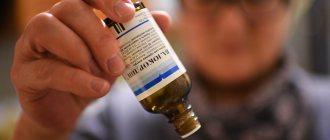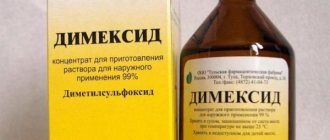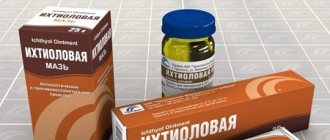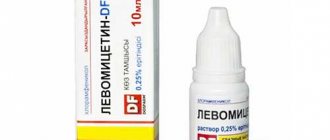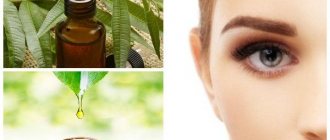A little history
The name Sintomycin speaks for itself. The word has two roots: -synth-, indicating the synthetic origin of the substance, and -mits-, borrowed from the name of the producing microorganisms - the Actinomycetes Streptomyces venezuelae.
The compound was first isolated from culture fluid in 1947. Syntomycin substance is a racemate - a mixture of equivalent quantities of two spatial configurations (D and L) of one chemical compound, Chloramphenicol. Later, a levorotatory isomer was isolated from this mixture, which was given the logical name Levomycetin.
Side effects
If the drug causes burning, itching, swelling, redness and allergic reactions in the patient, it is recommended to discontinue its use. Also, you should not use synthomycin ointment for the face for a long time . Possible side effects with prolonged use of the drug:
- Development of bacterial resistance to the active components of the drug. Subsequent treatment will be ineffective.
- The drug has an antibacterial effect. Together with pathogenic bacteria, it destroys beneficial microflora. This can lead to dry skin and weakening of its protective functions.
- The risk of adverse reactions increases. Only a specialist can prescribe the correct treatment.
It is not recommended to use Syntomycin simultaneously with Clindamycin, Lincomycin and Erythromycin. When chloramphenicol interacts with these antibiotics, its effectiveness is significantly reduced.
Before using the ointment, it is imperative to do a test to ensure that there is no hypersensitivity to its components. To do this, apply a small amount of the product to your wrist, inner elbow or skin behind the ear. If after 5-10 minutes there is no burning or redness on the treated area, then the drug can be used to treat acne on the face.
Composition and release form
Synthomycin ointment is one of the effective means for treating acne; it is a drug with a bacteriostatic effect. It is a creamy mixture of milky white or yellowish color.
Let's take a closer look at the composition:
- Chloramphenicol (D, L) 10g;
- Castor oil (base) 20g;
- Emulsifier No1 (emulsifier) 3-5g;
- Sorbic acid (preservative) 0.2g;
- Carmellose sodium (polymer, prolongator) 1.84g;
- Purified water 100g.
Based on the composition, we see that the name ointment is incorrect, since the mixture of oil + emulsifier + water forms an emulsion, and the addition of a polymer stabilizes it and the result is a liniment. The ointment is based on solid fats. Therefore, the correct name is Syntomycin liniment .
The presence of antimicrobial activity is due to the first component - Chloramphenicol, or rather its racemic mixture, purified from toxic by-products. It is worth immediately noting that the racemic mixture has 50% of the activity of the most active isomer - Levomycetin, that is, the liniment in fact is not 10%, but 5%, but this is still better than Levomekol (0.75%) and Levosin (1 %).
The product can be found in dark glass jars of 20, 25 grams, aluminum tubes of 20, 25, 30, 40 grams with a screw cap, placed in a cardboard box along with instructions for medical use. It is sold in pharmacies without a prescription and is usually stored in the refrigerator.
Description of syntomycin ointment
The active ingredient is a broad-spectrum antibiotic called syntomycin , another name is chloramphenicol. It is an active fighter against a number of bacteria that penicillin, streptocide and sulfonamides cannot fight. By dissolving fats, synthomycin penetrates the bacteria and destroys internal physiological processes. Namely, it slows down to a minimum the movement of amino acids that should nourish the peptide chains. As a result, protein synthesis is disrupted and bacteria stop growing and multiplying.
Very effective against:
- gram-positive bacteria - staphylococcus, streptococcus;
- gram-negative bacteria – gonorrhea, meningitis;
- spirochete.
Can be combined with other medications - nystatin, erythromycin. Such complexes improve the pharmacological properties of drugs. But the combined effect with other antibiotics, for example, may be slowed down, but not critical. It is strictly incompatible with the sulfonamide group, barbiturates and others. In any case, when taking other medications, you should consult your doctor and read the instructions carefully.
You should not take syntomycin during radiation therapy, or for a long time after.
The basis of syntomycin ointment is castor oil. It is made from hazel nuts. The beneficial properties of castor oil have been known for many centuries; it is most often used in cosmetics. After all, castor oil can treat not only skin, but also hair and nails. This oil treats skin fungi, corns, and small warts. It easily heals small cracks and speeds up the healing process of small scratches.
It can be used to treat acne and lighten freckles. It also improves not only skin color, but also, by softening it, increasing regeneration and improving water balance, it improves the elasticity of skin cells and their nutrition. Dryness and flaking go away.
These components of syntomycin ointment help not only fight harmful bacteria, but also speed up the healing process of wounds.
How does Syntomycin work?
The product exhibits antimicrobial activity against gram(+) and gram(-) microorganisms, including the main causative agents of acne and acne. The antibiotic is effective against strains of bacteria resistant to penicillin, tetracycline and sulfonamides. The resistance of microorganisms does not develop quickly; however, long courses should not be carried out unless otherwise prescribed by a doctor. There is no cross-resistance with other antibiotics.
Chloramphenicol in synthomycin exhibits a bacteriostatic effect due to inhibition of peptidyl transferase, an enzyme involved in protein synthesis. Thus, the cell does not die immediately, but loses the ability to divide and function normally, and after going through the natural cycle of life it dies.
Characteristics of the drug
The main active ingredients included in Synthomycin ointment are castor oil and chloramphenicol. Additional components are water and sodium carboxymethylcellulose. Functions performed by castor oil:
- cessation of the inflammatory process;
- moisturizing the affected skin area;
- antimicrobial effect;
- decreased sebum production;
- regeneration of skin tissue.
Chloramphenicol is a substance of synthetic origin that is a powerful antibiotic. It disrupts the protein synthesis of infected cells, causing them to stop reproducing and die. Bacteria have low resistance to the component. The antibiotic quite effectively fights boils and purulent pimples, as it penetrates deeply into the tissue, providing a therapeutic effect.
Additional components of syntomycin have a keratolytic effect. They help exfoliate dead epidermal cells, leading to blockage and inflammation. The ointment prevents the appearance of acne, but does not help get rid of its consequences (traces and spots).
Indications for use
Sintomycin is used for the following indications:
- Wounds in the second stage of the wound process (in the absence of pus and necrotic tissue);
- Shallow pimples and acne (papulopustular form);
- Long-term non-healing trophic ulcers;
- Burns 1,2,3 degrees.
How to deal with lip herpes?
Most of us, either ourselves or other people, have seen unpleasant pimples on the edges of the lips that take a long time to break out, and then an unpleasant crust appears. This is popularly called a cold or fever. So what is this disease really and how to deal with this scourge?
So, a little scientific. What is this cold on the lips? In medicine, it is caused by the herpes simplex virus type I. According to scientists, it is present in the body of 90% of people. There are several types of virus. Recently, evidence has emerged that different types of herpes viruses can transform into one another.
The herpes virus that causes colds on the lips, once it enters the body, remains there for life
. Although opinions on this differ. Some doctors claim that it is not for life, but only for 60 years.
According to statistics, approximately every fifth Russian has herpes on the lips from 2 to 10 times a year. And only 5% of all people on Earth are immune to the herpes simplex virus. The reasons for this are still unknown to doctors.
How can you get infected with herpes?
The virus enters our body, as a rule, in early childhood. But the virus itself may never manifest itself in all its glory, and a person may simply not know about its existence in his body. An infected person transmits the virus with saliva, so it is strictly not recommended to lick the spoon or pacifier intended for the child, as some mothers do - for disinfection and to allow those who have rashes on the lips to kiss the baby.
Once in the body, the virus reaches the nerve endings and waits for the right moment to intensify its activity. The catalyst for the virus can be a moment when immunity is reduced, and often this happens in the fall and winter. Herpes can also be activated by a cold, menstruation, stress and overwork, hypothermia or overheating.
Stages of the disease.
When the disease begins, it goes through 4 stages in its development. But the most important of them, in my opinion, is the first. It is then that you can influence the course of the disease and its duration. At the first stage, you begin to feel a slight tingling in the place where the cold is about to appear, redness, and itching. Right now is the time to start actively using medical treatments that can often completely prevent the development of the disease.
At the second stage, a small bubble of liquid appears. At the third stage, the bubble ruptures and a colorless liquid flows out of it, and in its place a small ulcer forms. Important!
It is at this moment that you are most contagious to others! And it is precisely because of the pain and extremely unpleasant appearance that this phase annoys people the most.
It’s trivial, but true - you must especially carefully follow all the rules of hygiene! This will not only help you, but also protect the people around you from this disease. Wash your hands often and try not to touch the sores. For a while, it is strictly contraindicated to kiss, use the same lipstick with a friend (this should not be done, even if you do not have herpes), and also drink from the same glass with someone else.
Do not try to remove any crusts that have formed. New ones will still appear in their place, but you will become even more infectious. During illness, use individual utensils.
Apply the medicinal ointment not with your hands, but with cotton swabs. This way you will not introduce foreign infection into the wound.
If the illness lasts more than 10 days, then consult a dermatologist, since a cold can be not just a disease in itself, but also a symptom of other diseases that require specialized treatment.
Modern pharmaceutical companies offer a lot of different drugs with an antibacterial effect, but synthomycin liniment ointment is undeservedly forgotten. This broad-spectrum remedy helps in the treatment of several dozen diseases.
Contraindications
Despite the fact that this drug is exclusively for external use, it is applied to open and treated wounds (under a bandage), and given the good penetration of Synthomycin into tissue, part of the substance may enter the systemic bloodstream.
Before use, please read the contraindications:
- Pregnancy and lactation;
- Neonatal period (up to 4 weeks);
- Fungal skin diseases, psoriasis, eczema;
- Individual intolerance, including to the components of the drug;
- Inhibition of hematopoiesis and any forms of anemia;
- Acute intermittent porphyria;
- Renal and/or liver failure;
- Glucose-6-phosphate dehydrogenase deficiency.
What to choose: Levomekol or Syntomycin?
In the treatment of purulent wounds and skin lesions of various types, Levomekol or Sintomycin is prescribed. The preparations contain an active substance with antibacterial activity. They have a number of distinctive features that allow their use depending on the clinical case.
In the treatment of purulent wounds and skin lesions of various types, Levomekol or Sintomycin is prescribed.
Compound similarities
Medicines contain the same substance - chloramphenicol. However, Sintomycin includes only 1 active ingredient, and Levomekol also contains methyluracil. The properties of substances are characterized by the following:
- Chloramphenicol belongs to the group of antibiotics. It has a broad bacteriostatic effect, disrupting the protein synthesis of pathogenic flora. Activity is manifested against microorganisms that are resistant to sulfonamides, penicillin and streptomycin. Resistance to chloramphenicol develops slowly.
- Methyluracil is characterized by anti-inflammatory activity. The substance has a beneficial effect on tissue trophism, stimulates recovery processes, and accelerates epithelization.
Both drugs are used externally. They are produced in tubes and look like a thick mass. Levomekol is also sold in glass jars.
Differences between Levomekol and Sintomycin
Sintomycin is a monocomponent drug, and Levomekol is a complex drug that contains 2 active ingredients. This is the main difference. Thanks to the combined composition, Levomekol remains active in the presence of purulent and necrotic masses. This explains some differences in the indications:
- Syntomycin is used to treat wound infections in the absence of purulent contents, burns and trophic ulcers.
- Levomekol is prescribed for the treatment of purulent wounds, including those with mixed infection. The product is effective in the purulent-necrotic phase.
Both drugs effectively destroy pathogenic flora. Levomekol additionally draws out purulent discharge and accelerates wound cleansing and healing.
Levomekol additionally draws out purulent discharge and accelerates wound cleansing and healing.
Another difference between the drugs is the concentration of the antibiotic. chloramphenicol in Synthomycin is several times higher than the amount of substance in Levomekol.
Can I take it at the same time?
At the same time, drugs are not prescribed, because this is not advisable. The products contain the same substance; when used in combination, there is a high probability of overdose, which can cause side effects. The attending physician decides which ointment is more effective in each individual case.
Contraindications
The drugs should not be applied to skin areas affected by eczema, psoriasis, or fungal infection. The use of the drugs is contraindicated in the presence of hypersensitivity to the active substances.
Sintomycin has additional contraindications:
- disorders of bone marrow hematopoiesis;
- functional disorders of the liver and kidneys;
- decreased activity of glucose-6-phosphate dehydrogenase;
- intermittent porphyrin disease.
Also, both drugs are not prescribed to newborns, during pregnancy and lactation.
How to take Levomekol and Sintomycin?
Levomekol is used to loosely fill wounds with an impregnated gauze bandage. The ointment is injected into the purulent cavities using a catheter and syringe (the substance is first heated to 36°C). The attending physician determines the required number of dressings and dosage, as well as the duration of therapy.
Syntomycin is applied after surgical treatment of wounds. Direct application to the wound under a bandage or dressing of the damaged area of skin with impregnated material is possible. It is possible to use soaked tampons to fill wounds and fistula passages. The amount of the drug and dressings are prescribed by the attending physician.
Syntomycin is applied after surgical treatment of wounds.
Side effects of drugs Levomekol and Sintomycin
An undesirable effect when using Levomekol may be allergic reactions in the form of skin rashes.
List of side effects of Syntomycin: Quincke's edema, allergies, decreased levels of granulocytes, reticulocytes, erythrocytes, leukocytes, platelets. Aplastic anemia may develop.
Conditions for dispensing from pharmacies
The drugs are available without a prescription.
Reviews from doctors
Igor Stepanovich, surgeon, Ryazan: “Levomekol shows high effectiveness in the treatment of fistulas and purulent wounds. Has the property of raising local immunity. Sometimes patients complain of an ingrown toenail. The mentioned ointment helps to correct the situation. Placing small flagella impregnated with ointment is effective.”
Irina Vladimirovna, therapist, Novokuznetsk: “Levomekol copes well with inflammation of various localizations. Cleans the wound surface and reduces swelling. Sintomycin copes in uncomplicated cases.”
Mikhail Petrovich, chief physician, Samara: “I recommend both ointments for rapid wound healing. It should not be overused; it should be used according to the regimen recommended by the doctor. These products are effective and inexpensive.”
Alina Viktorovna, infectious disease specialist, Moscow: “Both drugs cope with their tasks. Selection is carried out individually. Infected wounds are difficult to treat; therapy cannot be done without local antibacterial agents.”
Patient reviews
Dmitry, 36 years old, Voronezh: “Levomekol often helped out in different situations. I applied ointment to treat a boil and treated a wound on my leg. Helps avoid complications and healing occurs faster.”
Boris, 62 years old, Ufa: “I always keep Syntomycin in my home medicine cabinet. It helps my wife with an exacerbation of herpes on her face. Once, on the recommendation of a doctor, I applied it to the resulting burn, the treatment gave a quick result.”
Irina, 25 years old, Moscow: “I always have both ointments at home. The mother treats trophic ulcers with synthomycin ointment; Levomekol was used to eliminate the child’s fistula after surgery for an umbilical hernia. Grandma uses it to treat cracked feet. The product helps speed up the healing of deep cracks that do not go away for a long time.”
Valeria, 51 years old, Zelenograd: “I use syntomycin ointment to apply to trophic ulcers. Last year, this remedy was used to treat my son’s wound. I’m satisfied with the result.”
Price
The price of Synthomycin ranges from 100 to 200 rubles, Levomekol has an average cost of 40-150 rubles.
Source: https://golitsyno-city.ru/allergiya/levomekol-ili-sintomicin
Methods of using Sintomycin ointment
This drug can help you treat a large number of mechanical and bacterial damage to the skin.
To prevent contamination of wounds and burns
Let's look at how to use Syntomycin ointment correctly.
The drug must be applied to clean wounds and burns. If there is slight pus, the wound must be treated with hydrogen peroxide and rinsed, and, if necessary, pus and dead tissue must be removed mechanically.
Only after this apply a breathable sterile bandage with Synthomycin liniment, which should be changed 3-4 times a day.
For acne and blackheads
Liniment is often used as the first treatment for inflammation, but it must be used correctly.
This drug does not have osmotic activity, therefore it is not recommended to apply it to boils and deep subcutaneous pimples. However, if the pimple contains pus and is not deep, then the use of syntomycin will accelerate its maturation and release of pus out.
After which the discharge can be removed mechanically. Then wipe the skin at the site of the pimple with an alcohol-containing solution:
- Calendula tincture;
- Chamomile tincture;
- An alcohol solution of chlorhexidine;
- Salicylic acid 1% or boric acid;
- Levomycetin alcohol.
Then reapply this product or any other that has an antimicrobial and wound-healing effect, for example:
- Levomekol;
- Levosin;
- Metrogyl gel;
- Tetracycline ointment.
If you use syntomycin for acne on the face, you will notice that it is well distributed on the skin and is almost invisible after absorption. Therefore, it is possible not to remove its residues some time after application, provided that it is applied in a thin layer.
You can apply it under powder or foundation, having first checked the compatibility of these products on your hand (so as not to suddenly discover that the foundation has rolled off).
It is equally effective to apply Syntomycin in a thick layer and keep it on the skin for a couple of hours, or to apply it twice to the pimple in a thin layer. In the first case, the product will be of great help if you have an event in the evening, and you notice that a pimple has appeared a few hours before the celebration.
Below is a photo with dynamics of 1 hour. On it you can clearly see the effect of the medicine.
Syntomycin is also perfect for the treatment of acne, comedones, post-acne spots after complete healing of the wound, as well as folliculitis at an early stage and acne on the back.
Synthomycin liniment for acne and post-acne
For such a fairly common phenomenon as dysfunction of the sebaceous glands, Syntomycin for acne is an indispensable remedy.
Dysfunctions in the production of sebum lead to increased growth and reproduction of bacteria on the surface of the skin and its tissues, which is the cause of papulo-pastules, popularly called acne. Synthomycin can be used as an independent remedy against acne. The use of the drug liniment syntomycin is also permitted in combination with funds from the folk piggy bank.
It should be used in accordance with the instructions accompanying its release. The necessary information can be gleaned by reading reviews from numerous users of liniment synthomycin.
Why Syntomycin?
Faced with the problem of acne on the skin, any person will look for a product that will not only cope with rashes, but will also do it in the shortest possible time. Syntomycin liniment 10% will come to the rescue. Acne ointment is also available in lower concentrations of 1% and 5%.
Synthomycin liniment is the official pharmacological name of a drug belonging to the group of antibiotic drugs. The ointment is characterized by the presence of a specific odor and is white in color.
How is such a high effectiveness of the ointment achieved? Its main distinguishing feature is the strongest antibiotic included in the composition - chloramphenicol. Thanks to it, the effect of eliminating point irritations, signs of superficial inflammation, ulcerative manifestations on the skin, as well as burns is achieved. The active substance is not only capable of stopping the growth of harmful bacteria, but also stops their reproduction.
The castor oil contained in the composition complements the action of liniment synthomycin. The effectiveness of this natural component is recognized in other recipes used in folk medicine. Castor oil, in addition to providing an antibacterial effect, fights age spots on the skin, lightening them.
Another positive effect of castor oil should be noted. The fatty base of the oil included in liniment syntomycin prevents excessive drying of the skin, but at the same time it does not clog the skin pores.
The information provided serves as proof that Sintomycin is able to cope with literally any manifestation of infection on the surface of the skin, which has an extremely negative effect on it.
In addition, syntomycin liniment has a number of other advantages, including the following:
- low cost of the drug;
- wide scope of application;
- the ability to purchase the product at any pharmacy;
- spot use of the product does not dry out the skin;
- the use of the product has high success rates;
- the drug fights not only the symptoms of diseases, but also their causes.
It is only necessary to take into account the important fact that, belonging to the group of antibiotic drugs, Syntomycin involves prescribing its use exclusively by a doctor, who will determine the dosage and timing of the course of acne treatment using this drug.
Rules and secrets of using Synthomycin ointment
It is best to start using Syntomycin when the first manifestations of foci of inflammatory processes are detected. It should be noted that Syntomycin easily penetrates into the deep layers of human skin.
When treating acne, the use of ointment should be preceded by washing your hands. After using Syntomycin, it is recommended to wash your hands with soap. Areas of inflammation and acne formation also require preliminary cleansing. To do this, it will be enough just to wash your face and dry your facial skin thoroughly with a towel, without injuring it.
If there is a single location of acne, you can organize a targeted effect, applying the ointment only to the inflammation itself. If a large area of skin is affected, it is necessary to apply the ointment to the entire surface of the skin.
A specialist should determine the frequency and frequency of use of Sintomycin ointment. He will pay special attention not only to the sites of inflammation, but also to the formation of purulent plaque on pimples.
There are frequent cases of using Syntomycin in the fight against spots left after acne. The method of using the product remains the same as described above. This is possible due to the excellent effects of castor oil in lightening such marks left behind by treating skin rashes.
Despite these recommendations for the use of this product, through experience, people are finding more and more effective methods of using it in each specific case.
For example, there is an opinion that you should not use only Syntomycin for a long time; greater results can be achieved by alternately using other ointments that are not antibiotics. But this should not be confused with the simultaneous use of two products on the same area of skin. This method of treatment threatens to result in even greater problems in the form of allergic reactions on the skin. In general, Synthomycin ointment can be addictive, and then its effect will subside. It is better to use syntomycin liniment and zinc paste alternately.
You need to pay attention to this
Despite the high effectiveness of the drug, it must be used correctly, following the instructions and recommendations of a dermatologist.
Synthomycin not only easily penetrates into the deep layers of the skin, but also has the ability to penetrate through the placenta to the fetus during a woman’s pregnancy. Therefore, if for the expectant mother the health of her child is more important than the appearance at the moment, then it is better to stop using Syntomycin for a while.
There is no information to date about the possible negative effects of Synthomycin on infants, therefore there are no restrictions on the use of the product during breastfeeding. But doctors recommend thoroughly rinsing or removing the remaining ointment from the nipples with a napkin if a woman treats cracks in this way.
The use of ointment for external treatment of skin imperfections is acceptable at any age.
You should strictly follow your doctor's recommendations on how often and in what quantity to apply Syntomycin to the skin, because too frequent use can be addictive, and little use will not give the desired effect.
If after using the product for a week the patient does not notice signs of improvement, he should consult a specialist about further treatment.
Possible side effects from Synthomycin include itching and burning sensations at the sites where the ointment is applied, swelling or rashes. But such cases are extremely rare. The use of Syntomycin is receiving more and more positive reviews.
Consumer Reviews
kakpersik.ru
Reviews
We invite you to read the reviews of ordinary people about the use of syntomycin, and if you have any questions, you can always ask your question on our cosmetic forum.
It is necessary to smear the skin with Sinthmicin when various rashes appear. If the pimple is opened, it needs to be treated up to 3-4 times a day. This method will prevent the pathogen from entering and will help a crust form faster. To prevent drying of the skin, it is necessary to apply the product pointwise! It is advisable to additionally moisturize the skin with serum or non-greasy cream.
Victoria, 21 years old
Syntomycin is an excellent remedy for treating acne. This product helps dry out acne on my face within 1 week. Pimples disappear quickly. Should be applied at night and spot-on. Additionally, I recommend cleaning the intestines with enteric sorbents and consuming bio-yogurt or kefir, which restore the functioning of the digestive tract. As a result of such actions, the skin is perfectly cleansed, bad breath disappears, and regular bowel movements appear. The ointment does not need to be used on an ongoing basis, but only in the presence of acne. I didn't notice any side effects.
Arina, 31 years old, Moscow
Syntomycin liniment always helps out when small pimples appear on the face, be it a small abscess or a subcutaneous pimple. I apply Syntomycin for acne not 2, but 3 times a day. The result exceeds all expectations: redness decreases and inflammation matures faster. The rashes do not go away completely as quickly as we would like, but it is faster than if they ripened on their own.
Olga, 26 years old, Kubinka
Use in pediatrics
The instructions for children indicate that the properties of Synthomycin ointment are not recommended for children under the age of 1 year. This is due to the fact that such unfavorable symptoms as nausea, vomiting, and flatulence were often observed.
For children aged from one to 3 years, the drug should be applied only after consultation with a pediatrician, with special caution.
Synthomycin ointment for burns is a highly effective drug; if the rules are followed, it is completely safe for adult patients. The undeniable advantages of the drug are its effectiveness and availability.
Features of use and dosage
Before starting treatment, it is advisable to determine the degree of sensitivity to the drug of the bacteria that caused the infectious disease.
Liniment is used exclusively externally by applying to the affected area of the skin. The latter should first be washed and blotted dry with a sterile cloth. Since the medicine may spread, it is recommended to apply a gauze bandage on top.
You can also additionally use compression or parchment paper. The dressing is done the next day, then on the 3rd, 4th and 5th. Course of application – 5 days. After application, wash your hands thoroughly with soap.
